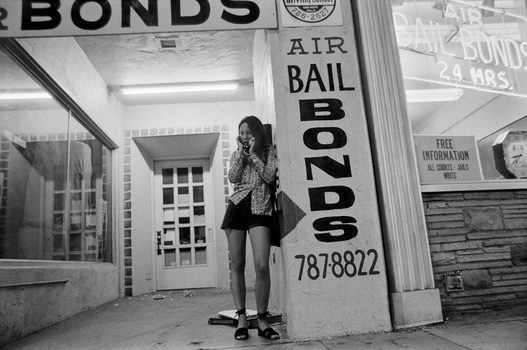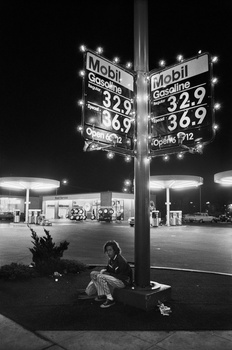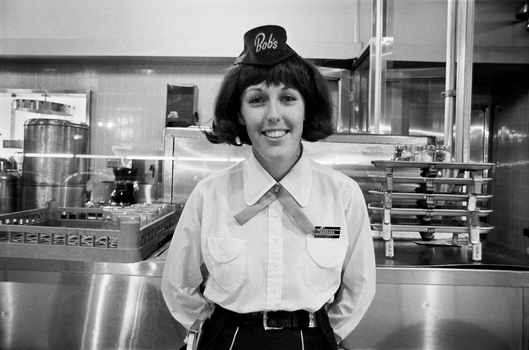In the days when film was king and gasoline cost less than 50 cents a gallon, photographer Rick McCloskey captured a vibrant car culture on the streets of LA in glorious black and white. Equal parts art and historical record, McCloskey’s work is a visual feast for street and film photographers alike.
Introduction
In 1972, America was feeling its oats. Having weathered the lost decade of the Great Depression and the turbulent years of World War II, Korea, and Vietnam, the good times were finally back. With the Vietnam War winding down, Nixon had started the legislative process to end the draft, and a generation of young men could breathe a collective sigh of relief. Eager crowds packed theaters to see Coppola’s “The Godfather”; Don McLean sang about the day the music died; and on Wednesday nights, kids from all over Southern California flocked to the streets of an LA suburb to be part of an incredible car culture that had blossomed along a stretch of Van Nuys Boulevard.
Like the hippie scene of Haight-Ashbury in the '60s, or the hip-hop movement that sprung up around Sedgwick Avenue in the Bronx in the '70s, the LA cruising scene was one of those iconic moments in American youth culture. If you were young and mobile and living in Southern California in 1972, Van Nuys Boulevard was the place to be seen. It was the gathering place for your tribe, and photographer Rick McCloskey was there to capture it all.
Rick grew up in the San Fernando Valley in the '50s and '60s, where he himself was part of the cruising scene that was almost a teenage rite of passage for many kids across America at that time. After graduating from college with a history degree and a minor in photography, Rick would return to the stomping ground of his youth to capture on film the kids, the cars, and the vibrant cruising scene of Van Nuys Boulevard that had been the backdrop to his own formative years.It was through the book of this project that was originally published in 2020, that I became a fan of Rick’s street photography. This beautifully printed and bound collection of Rick’s stunning images is a real treat for anyone who is into street or film photography. When I approached him to ask if he would be willing to share some of his images with us and maybe even offer us a few insights into his approach and his process as a street photographer, you can imagine how delighted I was when he enthusiastically agreed—and so here we are!
Before going any further, I just want to say how grateful I am to Rick for giving me permission to use his images in this article and for his patience in answering the many questions that I peppered him with about his approach to the Van Nuys project and street photography in general. This article would not have been possible without his support, and later on, we will get to some of the great insights that he shared with me. Wherever possible, I will quote Rick directly in his own words, and those passages will appear in block quotes.
Following in the Footsteps
Street photography has absolutely blossomed as a photographic genre over the last few decades. Like many fine art photographers who have bucked the trend to go digital, street photographers are often in the vanguard of analog photography. In spite of all the premature lamentations of the early aughts that “film is dead,” we now find ourselves in the midst of a true renaissance in film—a match made in heaven for the genre of street photography.
It is very apropos then, that in this predominantly digital age, there is still a great deal that we can learn from the elder statesmen of street photography for whom film was once the only game in town. In the 1970s, photographers like Rick never considered that they were working within the “limitations” of film, as if there was some “better” choice available.
Film was the medium. Period.
If you photographed at night in low light as Rick did, you had to learn how to coax the absolute best out of your film stock and how to adapt the way you shot your subjects to its particular capabilities in challenging light conditions.
As street photographers, what we can learn from Rick’s experience goes beyond the necessity and the means to develop a mastery of your craft. It can also serve as a guide to where and how to channel your artistry. Rick’s starting point for his photographic journey was the compelling material of his own life. The LA cruising scene held a deep fascination for him growing up, and it was through his photography that he wanted to tell its story.
To build a cohesive body of work in street photography, it can be helpful to develop a theme around which you can find your own voice, and there’s no better place to start than with the stuff that you are most passionate about.
'I Owned the Cheapest Single Lens Reflex Camera on the Market.'
When Rick started his Van Nuys Boulevard project in 1972, his boundless creative drive stood in stark contrast to his modest means.I didn’t have a lot of money at the time. I owned the cheapest single lens reflex camera on the market, a Mamiya-Sekor 35mm that took Pentax screw mount lenses.
Rick’s film of choice was Kodak Tri-X ISO 400, a black and white film that is happily still available today (in spite of all the gloomy predictions about the death of film). Even this more sensitive film emulsion, however, did not really give Rick the exposure latitude he needed for the very low light conditions that he was typically working with. To remedy this, Rick would usually push the sensitivity of the film to ISO 800 in his development process—and even then, he was still working at the limits of what you could do with this film in such low light.
Many of my images were shot at long shutter speeds, 1/15, 1/8 - even 1/4. Wherever possible, I braced the camera on something, sometimes a car, sometimes a pole, often the ground itself. I did get good at hand holding very still. Probably 1/30 of a second was the shutter speed I used the most.
Despite the kind of incredible high ISO performance and multiple-stop image stabilization that we have come to take for granted with modern digital cameras, it is worth remembering that there was a time when photographers working in low light needed to learn how to hand-hold a camera for shooting at low shutter speeds, without ruining their images with motion blur. This is still the case if you’re shooting with film in low light, so it’s definitely a skill worth mastering even today. It’s also something that you can fall back on when you don’t happen to have an image-stabilized lens or camera body.
Although there are street photographers who prefer longer lenses for filling more of the frame with their subjects, wide-angle lenses have been historically favored for street photography since they allow the photographer to give the subject more context.
Rick practices a dynamic style of shooting street photography that allows for more rapid reframing of the scene in response to the changes taking place in front of the lens. This is particularly important when you’re shooting people.My go-to lens was a 28mm wide-angle, both because it allowed me to radically change compositions with very slight movements, but mostly because it had a reasonable depth of field at f4 or f5.6. Rarely did I get to use f8 or higher for night work. The wide angle enlarged the visual space in the pictures, giving the boulevard a lot of depth, and the subjects a lot more room to play their parts.
I have always preferred shooting from the hip, rather than looking through the viewfinder, which always gives your intended subject a tip off and time to react. I shoot fast, they react slowly, and maybe not at all, because they often were not sure whether I took a picture or not. I never shoot wide open - no depth of field.
You do see quite a few street photographers shooting at wider apertures in order to reduce the depth of field and create more separation between the subject and the background—plus, of course, there’s the additional bonus of the bokeh. We can’t forget the bokeh.
But shooting wide open with a very narrow depth of field does not fit well with Rick’s more “run and gun” style of street photography, since it requires the photographer to focus on the subject with much greater precision. When shooting fast and from the hip as Rick likes to do to capture rapidly changing scenes, the photographer seldom has the time in the heat of the moment to futz with precise focusing and risk losing the shot altogether.
By working with a narrower aperture even in low light, Rick was able to take advantage of the zone focusing effect in which everything in the scene within a certain distance on either side of the focal plane is in focus. This approach is also very well suited to wide-angle lenses, which offer a deeper depth of field than longer focal lengths.
'I Looked Just Like Most of Them.'
I wanted to ask Rick about a subject that seems to come up a lot in street photography forums and channels online. It takes a certain degree of courage and self-assurance to approach somebody on a street and take a picture of them. Photographing strangers on a city street at night is also not without its risks. I was curious to know how Rick approached this issue in the course of shooting his Van Nuys Boulevard project, and whether he had ever encountered any hostility from the people he was photographing.This always depends on the immediate situation. You need some street smarts, the ability to recognize a subject who may react poorly. Sometimes it’s best to just try to make a conversation first, put them at ease. Sometimes shoot fast, look like you know what you are doing and scoot.
I met Robert Frank in 1970, and got to view his enlarged proof sheets from ‘The Americans.’ As he approached subjects, he started shooting until he got as close as possible, then he grabbed a couple of shots as he quickly moved away. Usually the closest shots, maybe two, were the best of six or eight. I did the same thing on Van Nuys. Only I couldn’t shoot as many images due to the lack of light, I often had to be closer before pushing the button.
Lastly, I had long hair, I looked just like most of them.
Once you get used to shooting strangers on the street, it becomes second nature. Yes, you have to think about it, plan ahead, try to mentally ‘see' the picture you want as you approach a subject, decide the best direction or angle for your shot, and move in from that angle.
You have to try to compose that picture before you lift and point the camera.
Postscript
Now in its third and final edition with only a limited number of copies left, Rick’s book “Van Nuys Boulevard 1972” (publisher: Sturm & Drang), serves not only as a testament to his incredible artistry, but also as a historical record—a timeless snapshot of a moment in American cultural history. You can learn more about the Van Nuys Boulevard project at Rick’s website, and you can find beautiful, signed prints of some of the most iconic photographs from the project, in the gallery that features his work at The Hulett Collection.A photograph can tell a story in a way that words never can. Rick’s photographs tell the story of a generation who rode the wave of an American boom that sadly did not last. Fast forward a few months beyond those glorious summer nights on Van Nuys, and the boom would be over. An oil crisis would bring soaring gas prices and harder times; and with harder times would come a hardening of local attitudes towards the use of public streets as a playground for the indolent young and their cars.
Within a decade, the playground would be closed and the vibrant cultural scene it had supported, gone—living on only in images like those that Rick captured with his camera during those summer nights on Van Nuys.
But I’m going to give the last word to Rick, because this is after all, his story to tell.
My preference was for shooting the people, not so much the cars, they were only props - but the buildings and background were also important for the feel of the series. All of these kids are seniors now, and a surprising number of them have already passed - not easy to comprehend as I look at the big book of digitized contact sheets on my desk.
To me, they are forever young.
All images used with permission of Rick McCloskey.






















Great images and a great article - thanks. It probably strikes a chord as that was about the time I started out with a camera (also a cheap SLR that took screw mount lenses - a Zenit E), and dabbled in street photography.
We had a similar culture about that time in New Zealand, but the cars were very different.
Thanks Mike - I’m so glad you enjoyed the article and Rick’s wonderful photography.
Just to imagine all these gorgeous young people are now "old" or dead. This is what strikes me about these old photos, the memories that if not held will soon be forgotten. These are a pretty cool set of photos and mood.